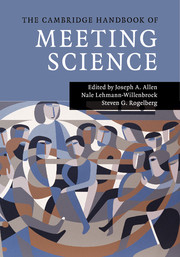Book contents
- The Cambridge Handbook of Meeting Science
- The Cambridge Handbook of Meeting Science
- Copyright page
- Dedication
- Contents
- Tables
- Figures
- Contributors
- Book part
- Part I Introduction
- Part II Premeeting Activities and Context
- Meeting Setup
- Meeting Composition
- Premeeting Communication
- Macro Meeting Context
- Part III The Meeting Itself
- Part IV Special Types of Meetings
- Part V Synthesis and Conclusion
- Book part
- Author Index
- Subject Index
- References
Meeting Setup
from Part II - Premeeting Activities and Context
Published online by Cambridge University Press: 05 August 2015
- The Cambridge Handbook of Meeting Science
- The Cambridge Handbook of Meeting Science
- Copyright page
- Dedication
- Contents
- Tables
- Figures
- Contributors
- Book part
- Part I Introduction
- Part II Premeeting Activities and Context
- Meeting Setup
- Meeting Composition
- Premeeting Communication
- Macro Meeting Context
- Part III The Meeting Itself
- Part IV Special Types of Meetings
- Part V Synthesis and Conclusion
- Book part
- Author Index
- Subject Index
- References
Summary
Low meeting quality is often attributed to poorly planned and poorly led meetings. In recent years, an increasing number of scientific studies have examined the effects of principal meeting design characteristics on employees' perceptions of meeting satisfaction and effectiveness. The aim of this chapter is to provide an overview of the literature and research on premeeting factors and design characteristics that have been identified as important: temporal characteristics related to how meeting time is used (e.g., starting and ending on time, pre-meeting talk), procedural characteristics that direct attendees' attention and efforts toward task-oriented activities (e.g., using a written agenda, setting clear goals), physical characteristics that relate to meeting settings and environments (e.g., appropriate venue quality, provision of refreshments), and characteristics of attendees. Our review shows how meeting leaders have the ability to design meetings more effectively and facilitate them in a manner that results in better outcomes. Based on the results of this review, we also discuss practical implications and directions for future research.
- Type
- Chapter
- Information
- The Cambridge Handbook of Meeting Science , pp. 47 - 90Publisher: Cambridge University PressPrint publication year: 2015

